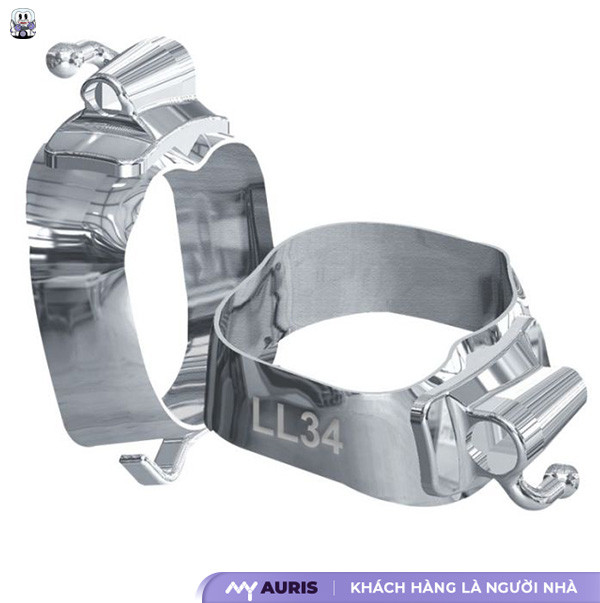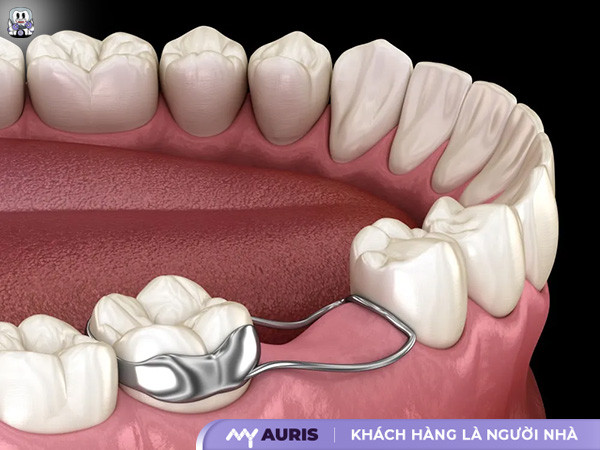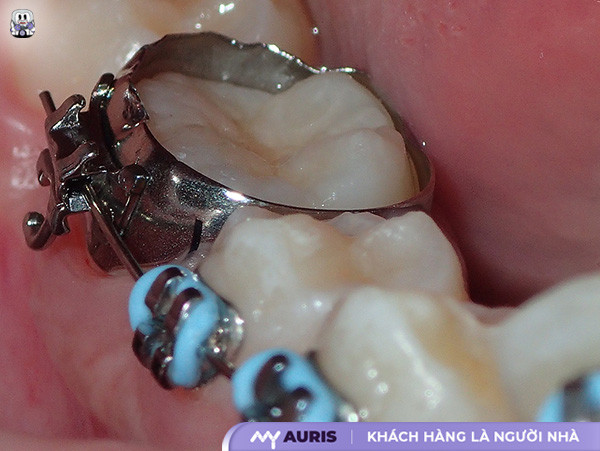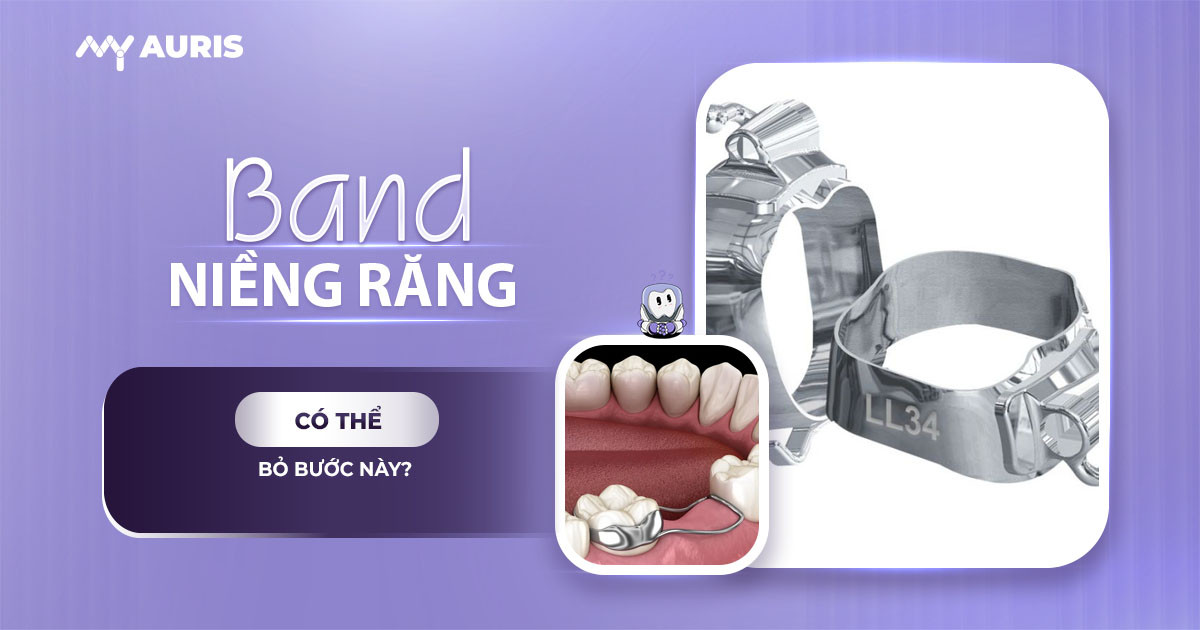Orthodontic bands, also known as molar bands, are important supportive tools that help move teeth into their ideal positions. Unlike archwires and brackets, which are already familiar, orthodontic bands are still a new concept for many people. This article from My Auris shares essential information to help you understand them better.
What are orthodontic bands?
Orthodontic bands are made of metal, either round or square in shape, precisely sized to fit snugly around the surface of the permanent first or second molars (teeth #6 or #7) – positions that serve as anchors and stable supports for the archwire and bracket system, helping to move teeth into their correct positions according to the treatment plan.
The structure of orthodontic bands is specially designed to optimally support the orthodontic process:
- An external hook is used to attach elastic bands or springs, keeping the appliances stable.
- A buccal tube on the outer cheek side houses the archwire, transmitting forces to move the teeth.
- A smaller tube on the lingual (inner) side is used to attach other supportive orthodontic appliances.
Bands not only play a fixed role but also contribute to precisely directing the pulling force, enhancing the effectiveness of orthodontics. If you are considering braces, discuss with your dentist whether you will need orthodontic bands.

Effectiveness of orthodontic bands
Orthodontic bands are important appliances often placed on teeth #6 and #7 – positions with large molars that require significant force to effectively move teeth. These teeth play a primary role in generating force and stabilizing the bracing process.
With their larger size compared to conventional orthodontic appliances, bands help anchor the bracket system, creating a stable foundation for the entire bracing structure. As a result, tooth movement is accelerated, significantly shortening the overall orthodontic treatment time.
Furthermore, orthodontic bands help adjust the bite on the dental arch, particularly effective for molars, thereby improving chewing ability and preventing oral diseases caused by malocclusion.
Common types of orthodontic bands
Orthodontic bands are an important component that helps secure braces and enhance their effectiveness. Choosing the right type of band will optimally support the treatment plan and be customized according to the patient’s dental condition. Below are the commonly used types of bands:
Molar Bands
These are common orthodontic bands placed on the posterior molars. They can come with buccal tubes to attach orthodontic appliances, optimally assisting in adjusting the pulling force.
Bicuspid Bands
These bands are placed on the bicuspids (premolars) – teeth located between the canines and molars. These bands help maintain stability for the bracing system and improve the pulling force.
Lingual Bands (inner bands)
Placed on the inner (lingual) side of molars, lingual bands are often used to discreetly and effectively secure orthodontic appliances.
Molar Bands with Buccal Tubes
The combination of a molar band and a buccal tube allows for more precise threading of the archwire, increasing stability and supporting the effective operation of orthodontic appliances.
Upper and Lower Bands
These two types of bands are used simultaneously to ensure that the upper and lower dental arches are consistently aligned and balanced, ensuring a smooth orthodontic process.
Standard Bands
This is the most basic type of orthodontic band, commonly used on posterior molars in routine orthodontic cases.

When are orthodontic bands placed? Detailed medically standard orthodontic banding procedure
Placing orthodontic bands is an important step in the orthodontic bracing process, helping to secure orthodontic appliances on the molars. However, band placement will be easier if there is sufficient space between the teeth. In cases where teeth are too crowded, the dentist will instruct the placement of orthodontic separators before proceeding with band placement. Conversely, if teeth are spaced out, with existing gaps, band placement will be quicker.
Below are the specific steps in the orthodontic band placement procedure:
Step 1: Oral examination and braces consultation
The dentist will perform an overall check-up of the oral health condition. If dental caries, periodontitis, or gingivitis are detected, the patient will be treated completely before proceeding with orthodontics. Concurrently, if the space between teeth is too narrow, the dentist will suggest placing orthodontic separators to create space for band placement.
Step 2: Oral hygiene
Before performing any procedure, the dentist will thoroughly clean the oral cavity to ensure a sterile environment when attaching the appliances.
Step 3: Placement of orthodontic separators (if needed)
Orthodontic separators will be placed for approximately 7 – 10 days. After the separator placement period, the dentist will remove them once sufficient space has been created for band placement.
Step 4: Placement of orthodontic bands
The dentist selects the appropriate band type for the molar size, then places the orthodontic band in the predetermined position. Fluoride-rich dental cement will be used to secure the band, effectively protecting tooth enamel throughout the bracing period.
Step 5: Attachment of other appliances to complete the system
After completing the band placement step, the dentist will proceed to attach other appliances to complete the orthodontic system within the oral cavity.

Does placing orthodontic bands cause pain?
Many people are still hesitant and worried about whether placing orthodontic bands causes pain. In reality, when the dentist places the band, this procedure is performed only on the tooth surface, similar to attaching brackets and archwires, so it causes almost no pain. However, discomfort may arise when force is applied to the band to move the teeth. The level of pain will vary depending on the condition of the teeth, the degree of spacing, or crowding among the molars.
To alleviate discomfort, you can use orthodontic wax or pain relievers as directed by your dentist. Orthodontic bands are not only important appliances but also serve as anchor points to connect other bracing components, accompanying you throughout the orthodontic process. The good news is that the initial sensation is only temporary – after a while, you will get used to it and can confidently continue your journey to a beautiful smile.
How long are orthodontic bands in place?
Orthodontic bands are crucial bracing appliances that create strong anchor points for the bracket and archwire system. This ensures that the pulling force from the brackets is effectively transmitted to move teeth to their desired positions.
Typically, orthodontic bands will remain in place throughout the entire bracing process, from the initial placement of brackets until the completion of orthodontic treatment and removal of all appliances. Once the teeth are beautifully aligned and the bite is corrected, the dentist will instruct the removal of the bands, officially concluding the orthodontic treatment.
During the period when bands are in place, proper oral hygiene care according to the dentist’s instructions is a key factor in ensuring a smooth orthodontic process, shortening treatment duration, reducing the time bands are worn, and especially preventing unwanted complications.





